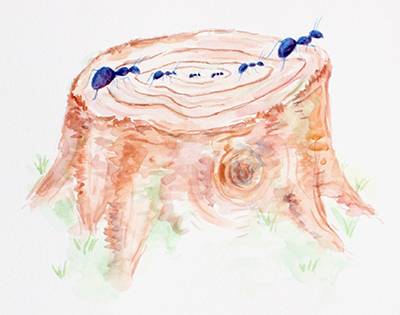
Chapter IX: Ants shrinking as they walk across a tree stump (geometries with varying scales). (Image courtesy of Talia Blum. Used with permission.)
Building on the example of the hyperbolic metric, we now consider metrics that are stretched by an arbitrary function (in technical terms, conformally flat metrics). The discussion focuses on the geodesic equation. Originally this is presented without any motivation, and you may feel that you landed in a nightmare version of a differential equations class. It takes quite a bit of computation to even see that, for hyperbolic geometry, the equation reproduces our previous notion of geodesic (experienced readers may notice that this computation uses Noether’s theorem, meaning the conserved quantities associated to the symmetries of the hyperbolic metric). Still, I hope that intuition eventually accretes around the formulae. The (standard) proof of the general Gauss-Bonnet theorem involves going back to the rotation numbers from much earlier in the class. Concerning the very last lecture, which tries to tie up things by looking back at combinatorial surfaces and polygonal billiards, I have to confess that so far I’ve never reached this material in class, so it’s more a dream of a lecture.
Lecture 37: The Geodesic Equation










